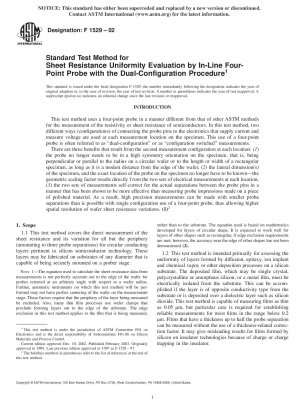ASTM F1529-02
Standard Test Method for Sheet Resistance Uniformity Evaluation by In-Line Four-Point Probe with the Dual-Configuration Procedure
- Standard No.
- ASTM F1529-02
- Release Date
- 2002
- Published By
- American Society for Testing and Materials (ASTM)
- Latest
- ASTM F1529-02
- Scope
1.1 This test method covers the direct measurement of the sheet resistance and its variation for all but the periphery (amounting to three probe separations) for circular conducting layers pertinent to silicon semiconductor technology. These layers may be fabricated on substrates of any diameter that is capable of being securely mounted on a prober stage.
Note 18212;The equation used to calculate the sheet resistance data from measurements is not perfectly accurate out to the edge of the wafer for probes oriented at an arbitrary angle with respect to a wafer radius. Further, automatic instruments on which this test method will be performed may not have perfect centering of the wafer on the measurement stage. These factors require that the periphery of the layer being measured be excluded. Also, many thin film processes use wafer clamps that preclude forming layers out to the edge of the substrate. The edge exclusion in this test method applies to the film that is being measured, rather than to the substrate. The equation used is based on mathematics developed for layers of circular shape. It is expected to work well for layers of other shapes such as rectangular, if edge exclusion requirements are met; however, the accuracy near the edge of other shapes has not been demonstrated (2).
1.2 This test method is intended primarily for assessing the uniformity of layers formed by diffusion, epitaxy, ion implant and chemical vapor, or other deposition processes on a silicon substrate. The deposited film, which may be single crystal, polycrystalline or amorphous silicon, or a metal film, must be electrically isolated from the substrate. This can be accomplished if the layer is of opposite conductivity type from the substrate or is deposited over a dielectric layer such as silicon dioxide. This test method is capable of measuring films as thin as 0.05 m, but particular care is required for establishing reliable measurements for most films in the range below 0.2 m. Films that have a thickness up to half the probe separation can be measured without the use of a thickness-related correction factor. It may give misleading results for films formed by silicon on insulator technologies because of charge or charge trapping in the insulator.
1.3 This test method can be used to measure the sheet resistance uniformity of bulk substrates. However, the thickness of the substrate must be known to be constant or must be measured at all positions where sheet resistance values are measured in order to calculate relative variations in resistance reliably.
Note 28212;The thickness correction factor for layers that are thicker than 0.5 times the probe spacing is known to vary more rapidly than that for single-configuration four-probe measurements, but such a correction has not yet been published. Until such a correction is published, resistivity values determined by the dual-configuration method will not be accurate for these thicker specimens; however, if the wafer has uniform thickness, variations of resistivity can still be determined by this test method.
1.4 This test method can be used to measure sheet resistance values from below 10 m for metal films, to over 25 000 for thin silicon films. However, for films at the upper end of this resistance range, and for films toward the low end of the thickness range, the interpretation of the sheet resistance values may not be straightforward due to various semiconductor effects (3, 4, 5).
Note 38212;The principles of this test method are also applicable to other semiconductor materials, but the appropriate conditions and the expected precision have not been established.
1.5 This test method uses two different electrical configurations of the four-point probe at each measurement location. It does not require measurement of probe location on the wafer, or probe separations, or of wafer diameter (except to determine edge exclusion for m......
ASTM F1529-02 Referenced Document
- ASTM D5127 Standard Guide for Ultra Pure Water Used in the Electronics and Semiconductor Industry
- ASTM F1241
- ASTM F374
- ASTM F42 Standard Test Methods for Conductivity Type of Extrinsic Semiconducting Materials
- ASTM F81
- ASTM F84
ASTM F1529-02 history
- 2002 ASTM F1529-02 Standard Test Method for Sheet Resistance Uniformity Evaluation by In-Line Four-Point Probe with the Dual-Configuration Procedure
- 1997 ASTM F1529-97 Standard Test Method for Sheet Resistance Uniformity Evaluation by In-Line Four-Point Probe with the Dual-Configuration Procedure (Withdrawn 2003)
